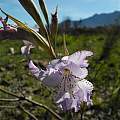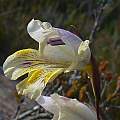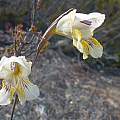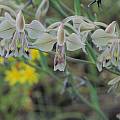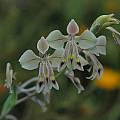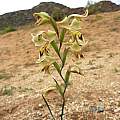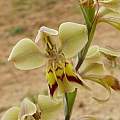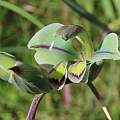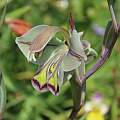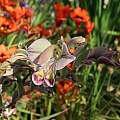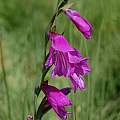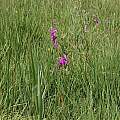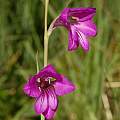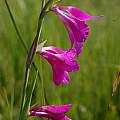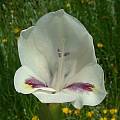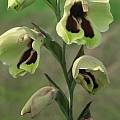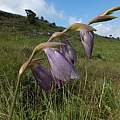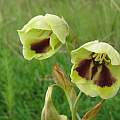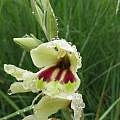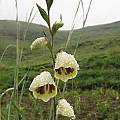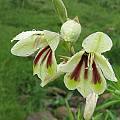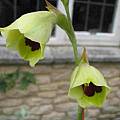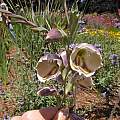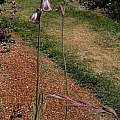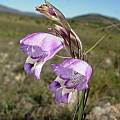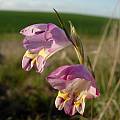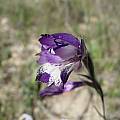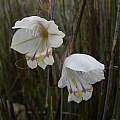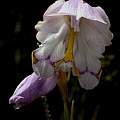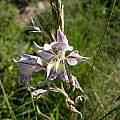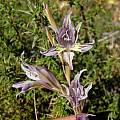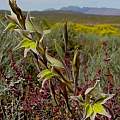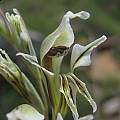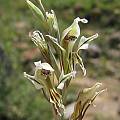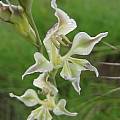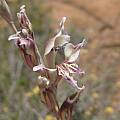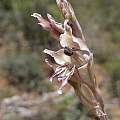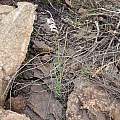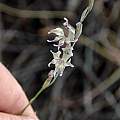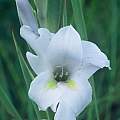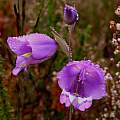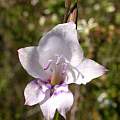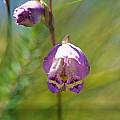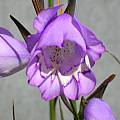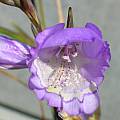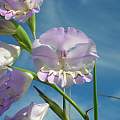Magenta to dark bluish purple is a another focus of Gladiolus diversity. Most of the Eurasian forms can be found here, but there are many South Africans as well.
Page 1: G. arcuatus... Page 2: G. imbricatus... Page 4: G. scullyi...
Gladiolus mutabilis is an Eastern Cape species and also occurs in the eastern part of the Western Cape. Plants grow in sandstone derived soils. This species has slightly fleshy leaf blades without thickened margins or midribs and an elongated corm that is two to three times as long as wide. Flower color ranges from pale to dark blue, mauve, brown or cream. The lower tepals are usually cream or yellow below with dark blue or brown dots and streaks on the yellow background forming the nectar guide. The fragrant flowers appear early in the season, June or July. The first photo was taken by Rachel Saunders who discovered this plant late July 2012 blooming in an area that had previously burned in the Western Cape. The next two photos were taken by Cameron McMaster August 2012 at the top of Potjiesberg Pass south of Uniondale (Eastern Cape) where it was growing with Gladiolus patersoniae. In the Western Cape population Gladiolus patersoniae was also in flower raising the question of whether they are both pollinated by the same pollinator. The last photo from the book Plants of the Klein Karoo courtesy of Jan and Anne Lise Schutte-Vlok.
Gladiolus orchidiflorus Andrews is found on clay and sandstone soils from Namibia to Cape Flats and also to Free State and flowers in the spring. It has linear to sword-shaped leaves that are thickened in the midline. Flowers are in a 5 to 12 flowered spike, windowed in profile, greenish to purple with dark purple markings on the lower tepals, and are very fragrant. Photos 1-2 are habitat shots taken in Namaqualand by Bob Rutemoeller and Mary Sue Ittner September 2006. Photos 3-4 were taken near Carolusberg, Namaqualand by Cameron McMaster September 2011.
The photos below were taken by Alan Horstmann.
Gladiolus palustris Gaudin is native to central and northwestern Europe, the most northerly range in the genus, and is suitable for ordinary to moist border conditions, as well as a bog garden. The normal flower color is rosy violet. Photos 1-4 from Hans Joschko. The pictured white form in photo 5 from Jane McGary was grown from seed sent by Ole Olsen of Norway, who cultivates the parent plants as a "blue" form. This species faces only one direction and does not have more than 6 flowers on a spike. We have been told this may be misnamed, but have not been given another name.
Gladiolus papilio Hook.f. (syn. G. purpureo-auratus, G. brachyscyphus, G. spathulatus, G. schlechteri) is called the Butterfly Gladiolus, and grows in marshy ground, up to 2400 m, from the Eastern Cape to Limpopo Province. It is claimed to be a hardy garden plant, grown in the UK since 1866. The first two photos were taken by Roy Herold in KwaZulu-Natal Province, near Kamberg in the foothills of the Drakensberg, in early December 2006. The third was taken by Rod Saunders. The fourth, an unusual color form, was taken by Rachel Saunders in the mountains above Tzaneen, early January 2015.
The photos below were taken by Cameron McMaster in Lesotho.
The first photo from John Grimshaw is of a form he labels in the "purpureoauratus" group. The second and third photos were taken by Bob Rutemoeller in the Mendocino Coast Botanical Gardens.
Gladiolus patersoniae is widespread in the southern African winter rainfall areas. It occurs in exposed rocky habitats in the interior ranges of the Cape Floral region, but also near the coast at Cape Infanta and on stony alluvial flats near Worcester. It grows on soils derived from sandstone. Plants grow to 50 cm and have narrow cylindrical leaves. The bell like short tubed and sweetly scented (similar to apple and carnation) pale to deep blue, slate, grey or cream flowers are pollinated by long tongued bees. The lower three tepals have a transverse yellow band usually outlined in dark blue or purple. Flowering occurs in late winter to spring, earlier at lower elevations. The first five photos by Cameron McMaster. His last one was taken August 2012 at the top of Potjiesberg Pass south of Uniondale (Eastern Cape) where it was growing with Gladiolus mutabilis. The last photo from the book Plants of the Klein Karoo courtesy of Jan and Anne Lise Schutte-Vlok.
Gladiolus permeabilis D.Delaroche grows on shale slopes in renosterveld from Caledon east through southern Africa and to Zimbabwe. In the Cape province it blooms late winter into spring. Usually 20 to 30 cm tall, but can be up to 50 cm, it has flat narrow leaves with a prominent midrib and mauve to dull purple or cream flowers with yellowish makings. Flowers are usually intensely fragrant. The first photo was taken by Cameron McMaster in the Overberg and the second by Bob Rutemoeller in the Bontebok National Park. The last photo below from the book Plants of the Klein Karoo courtesy of Jan and Anne Lise Schutte-Vlok
Gladiolus permeabilis ssp. edulis (Burch. ex Ker Gawl.) Oberm., syn. Gladiolus edulis, is widespread across the summer-rainfall zone and is common in the drier areas. This subspecies has whitish to cream, sometimes grey or mauve flowers. All of the tepals except for the dorsal have a grey to purple or maroon midline sometimes surrounded by a yellow streak. The lower lateral tepals are yellow in the upper half. Tepals have an elongated and tapering tip or tail-like twisted and undulate appendages. Photos taken by Cameron McMaster in two locations in the Eastern Cape.
The photos below were taken at Andriesberg by Cameron McMaster and Bob Rutemoeller in January and February, different years.
Gladiolus rehmannii Baker is a summer rainfall species that grows in sandy soils, often in rocky ground in light woodland in the northern part of South Africa to eastern Botswana. Growing from 30 to 50 cm, it has white to pale lilac flowers with yellow nectar guides and is unscented. It blooms from mid January to March. Photo from Rod Saunders.
Gladiolus rogersii Baker grows to 60 cm and has narrow leaves with a prominent midrib. Flowers are blue to purple with yellow or white transverse markings on the lower tepals. In the Kammanassie Mountains flowers can be cerise-pink. This is a widespread South African species found on sandstone and limestone slopes in winter and year round rainfall areas and mostly blooms in spring. There are variants that flower from autumn to early winter on the foothills of the mountains in the Little Karoo. The first two photos and information from the book Plants of the Klein Karoo courtesy of Jan and Anne Lise Schutte-Vlok. The third photo by Mary Sue Ittner was taken of a plant growing on a slope east of Swellendam. Most of the flowers had been eaten by an insect. Photos 4-6 were taken by Alan Horstmann.
Page 1: G. arcuatus... Page 2: G. imbricatus... Page 4: G. scullyi...
